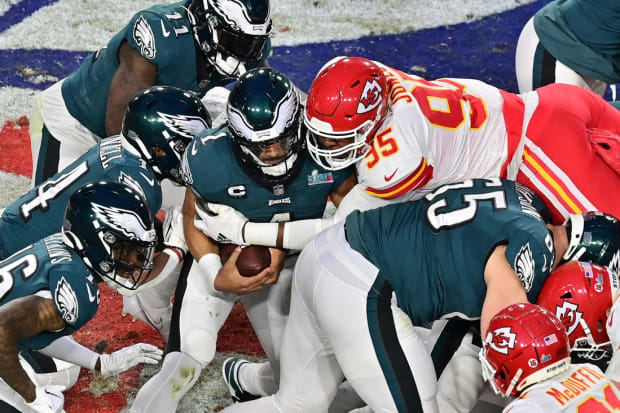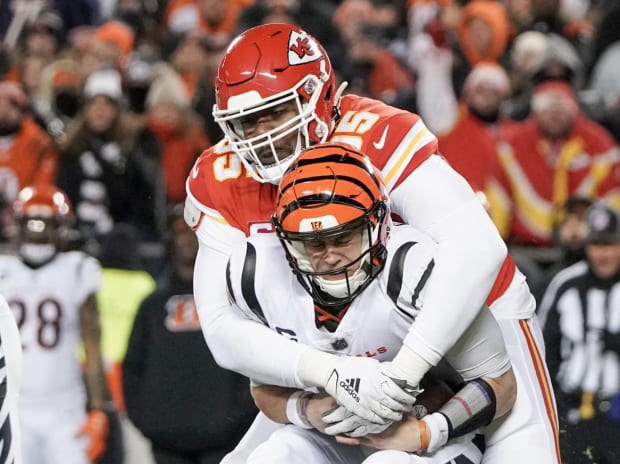Chuck Smith is a longtime pass-rush guru to NFL stars, a retired sack seeker himself and, as of March, the Ravens’ latest outside linebackers coach. Before he went to Baltimore, he sometimes trained Chiefs defensive lineman Chris Jones, giving Smith rare and valuable insight into Jones’s ongoing contract saga.
Smith recalls stumbling upon a magazine cover around 2008. He cannot remember the specific issue, but it featured Albert Haynesworth, the mammoth defensive tackle who moved like much smaller men, with nimble feet and elite agility. “The Big Man: Revolution of the Defensive Tackle,” the Sports Illustrated cover headline read. For much of the previous decades, defensive tackles had primarily been utilized to stop the run and take up space. But as offenses threw more (and more efficiently), defenses were forced to counter those adaptations, meaning they needed to keep more players in coverage and create the majority of any quarterback pressure through their defensive line.
Jones announced on social media this week that he was willing to hold out until Week 8, if necessary, if he couldn’t reach an agreement with the Chiefs on a new contract. He added, “I can afford it” for good measure. Why he can do that, why he can say that, and why he is doing both speaks to what Smith saw and how Smith connected that issue to his future trainee. He came to see Jones as a player who fit within the new paradigm laid out in that magazine article.

Matt Kartozian/USA TODAY Sports
Jones wasn’t a prototypical DT. He’s 6'6" and typically weighs around 300 pounds. He is strong, but he’s also athletic, agile, quick as hell, smart and shifty. His strengths do not necessarily feature technical prowess, but he has plenty of that, too. His transformational skill set, instead, is grounded in the totality of his gifts and how he toiled to maximize the combination of them. He is, according to retired NFL sack master Cliff Avril, “a monster” bent on terrorizing quarterbacks, offenses and full teams.
Which leads into an educated guess at how the Jones contract situation will unfold in Kansas City over the next few weeks. He wants an extension in the neighborhood of $30 million in average annual value, per two sources with direct knowledge of the negotiations. Chiefs personnel executives, as evidenced by their roster reconfiguration last offseason and the Super Bowl that resulted from Brett Veach’s deft drafting and signings and cap management, are not dumb. They know that Jones is a football unicorn, second only to Aaron Donald ($31.7 million AAV) in terms of elite NFL disruption specialists. It’s not difficult to argue, even, that Jones (15.5 sacks) had a better season than Donald last year (five sacks). The Chiefs want to pay him, plan to pay him and should be expected to pay him—in all likelihood, before their season starts Sept. 7 against the Lions at Arrowhead.
But Veach also has other parameters to consider, and they’re not dissimilar to Kansas City’s decisions before last season to let safety Tyrann Mathieu walk in free agency and trade Tyreek Hill to the Dolphins. K.C.’s problem is, of course, of the first-world variety. None of their competitors feel sympathy for a franchise that sits on the cusp of cementing the loftiest kind of status—as a true, bona fide NFL dynasty. The Chiefs wouldn’t be perched on that cusp if not for Veach and his underlings stuffing the roster with elite players. When they prove him right, they cost more, hence the holdup. K.C. will pay Jones, and will pay a lot for him. But the Chiefs still need to retain what cash and cap space they can, because Jones isn’t the only All-Pro they’ll need to pay—and soon.
Other than Mahomes, though, Jones is the most important player that K.C. hopes to invest in. And that speaks both to his skill set and how he sharpened it under the tutelage of Smith, Chiefs defensive coordinator Steve Spagnuolo and others. In seven NFL seasons, Jones was available, missing only nine games. He has been dominant—146 career QB hits, 243 tackles, 65 sacks; all despite playing primarily inside—and not just in the playoffs. Where defensive end Frank Clark turned up his sack rate primarily after the calendar flipped to January every year, Jones dominated weekly, the only variance in … how dominant. Clark departed for Denver this offseason. Jones is not likely to leave K.C. anytime soon. And those transactions, they’re related. The Chiefs made a conscious choice.
Makes sense. Coming out of Mississippi State, Jones was almost strictly a power rusher with endless potential and uneven game film. His size—smaller for a defensive tackle (310 pounds) but not a human being—helped him rush but limited his impact primarily to passing downs. Which is why he “slipped” into the second round of the 2016 NFL draft.
Whenever Veach evaluated Jones’s game film, he fell into moments of awe. He said, more than once, “Whoa! I’ve never seen that before.” But he also saw what other evaluators noticed—a perplexing inconsistency. He decided to take Jones anyway in Round 2, because, for him, potential outweighed Jones’s more persistent issues. “He had some games that were really head-scratching,” Veach said before Super Bowl LVII.
Jones then worked tirelessly to develop his own moves, adding craft and technique while maintaining speed and power. With more of all—more moves, efficiency and strategy, combined with more strength and speed—his defensive coordinator Spagnuolo could move him all over the field, including across from a nose guard, split wide, even standing up a few feet behind the line of scrimmage. This allowed the defensive coordinator known as Spags to move other players into more distinct positions, to double top wideouts or send extra blitzers. In other words, Jones changes how the Chiefs play defense, in both a schematic sense and a talent one.
The offense might hog the attention around the reigning champs. But the combination of Jones’s complete skill set, his versatility, and, before this year, how he worked in tandem with Clark, is what made that same defense more formidable than K.C. is credited for throughout last season’s title run.
Jones, Smith says, is the next logical step in the evolution laid out in that magazine article. He has scissor moves and swipes and head fakes, and he can get by offensive linemen with hand techniques alone, not to mention put together combinations. Throw in George Karlaftis, a rookie second-round draft pick last season, to draw attention away, and the Chiefs still possess the kind of pass rush that promised to test even an offensive line as elite as the Eagles’ unit—and did, throughout K.C.’s triumphant season.
“Chris is the closer, smooth, aggressive, a mismatch, can’t block him with one guy, complete but not as animated,” Smith says. “He brings the Chiefs that fight.”
Going into the AFC championship game last year against the Bengals, Jones didn’t have a single postseason sack on his résumé. Don’t mistake that for no impact, because his play is always impactful, sacks or not. Veach could see all the attention paid to Clark’s postseason sack tally bothered Jones. “He was hard on himself,” Veach said.
In the week before that game, Veach said, every person in the building noted, over and over, the importance of keeping Cincy’s offense off the field. They could do that only if Jones was Jones.
“Talk about a guy who made the game personal,” Veach said, noting that Jones was one Chief who fired back at all the trash-talking Bengals. “He was not going to be denied. When Chris is on his A game, there isn’t a line in the NFL that can stop him. He demands double teams. And, even when they double him, he’s gonna find a way.”
Veach told colleagues before that Bengals clash that he had a premonition. Quarterback Patrick Mahomes was playing on a severely injured ankle. Jones, Veach believed, would come through. “And,” Veach said, only a few days after that performance, “he came through in an epic way, just an unbelievable performance.”

Denny Medley/USA TODAY Sports
Against Cincinnati, on a frigid night at Arrowhead Stadium, Jones sacked Joe Burrow twice. Jones also recorded 10 pressures and five QB hits. It’s safe to say K.C. wouldn’t have won the Super Bowl last season without him, playing like that, when the Chiefs most needed exactly what Jones gave them.
Late in that game, Veach made his way down to the field. He hoped to celebrate another conference championship, which meant the Lamar Hunt Trophy, named after the organization’s founder, would remain where it belonged for another year at least. The first person he ran into on the field? Jones.
The general manager wrapped the big defensive tackle in a bear hug, all but threatening to lift Jones’s 300-ish pounds right off the ground. Veach told Jones he admired the work Jones had done the previous offseason. “Good game is a drastic understatement,” Veach told him. “You were absolutely dominant, man.”
“He’s relentless,” head coach Andy Reid added before the Super Bowl. “He’s a mindset guy. And, when those juices are flowing, like they always flow, he’s tough to stop.”
“I give the Chiefs a lot of credit,” Smith says. He means their investment in Jones, their ability to bring the best out of him and their deployment of him in an ever-shifting NFL pass-rush landscape.
Does any of that change, as negotiations drag? Of course not. Can K.C. pay Jones every dollar remaining under the salary cap? Veach can’t do that, either. But it’s safe to say that Jones will play, this season, in Kansas City, for the Chiefs. There’s too much at stake for any other scenario to play out.







